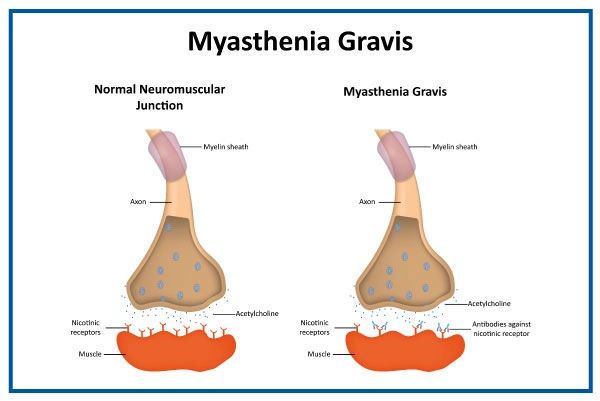
Myasthenia Gravis
Myasthenia Gravis is an auto-immune disorder, in which antibodies circulating in the blood causes weakness by blocking acetylcholine receptors at the neuromuscular junction, inhibiting the stimulative effect of the neurotransmitter acetylcholine. There is an effective treatment available now by alleviating or reducing the symptoms like arm / leg weakness, double vision, drooping eyelids, speech difficulties, chewing, swallowing and breathing. In fact, many people with the disease become completely free of symptoms after our effective treatment provided by team of experts. Symptoms generally worsen with physical activity and improve after resting or a good nights sleep.
Myasthenia Gravis affects 1 or 2 people in every 10,000. It occurs more commonly in women under 40 years and men over 60. However, it may affect individuals of any age and we have largest experience in India for treatment of Myasthenia Gravis.
Signs and Symptoms of Myasthenia Gravis
The main feature of Myasthenia Gravis is the patients susceptibility to fatigue-
A symptom is something the patient feels and reports, while a sign is something other people, such as the doctor detect.
Muscle weakness severity varies greatly among patients with Myasthenia Gravis. Sometimes the weakness may be in a localized form, such as just the eye muscles, while in other cases it may be in a severe or generalized form in which many muscles are affected; Muscles become progressively weaker during periods of activity and improve after periods of rest.
Eye muscles - in over 50% of patients the first signs and symptoms involve eye muscles, including such problems as ptosis (drooping of one or both eyelids), diplopia (double vision), and blurred vision (which may be intermittent). For about 15% of patients, only the eye muscles are affected - in such cases their condition is known as ocular myasthenia. Limbs - the arm and leg muscles may weaken, affecting such activities as lifting or walking (the patients walk may seem like a waddle). When limb muscles are affected, this generally occurs in conjunction with other muscles in the body, such as the throat, eyes, or face. Facial muscles - for approximately 15% of patients the first symptoms involve the throat and face muscle. In such cases individuals may have problems with:
Speaking (dysarthria) - depending on which muscles are affected, speech may become soft or nasal.
Swallowing (dysphagia) - the patient may choke easily, making eating, drinking, swallowing pills harder. Sometimes when the individual tries to drink, the liquid comes out of his/her nose.
Chewing - muscles used for chewing may weaken considerably during a meal, especially if the person has been eating something hard or chewy. Facial expressions - some people may develop an unusual or different smile if certain facial muscles are affected.
Treatment Options for Myasthenia Gravis
There is no cure for myasthenia gravis. However, most therapies (treatments) are very effective in controlling symptoms. In fact, the majority of Myasthenia Gravis patients who undergo treatment become completely free of symptoms and can lead normal (or near-normal) lives.
- Cholinesterase inhibitors -
- Steroids or Immunosuppressants
- Removal of the thymus gland (Thymectomy)
- Plasmapheresis and Immunoglobulin therapy
- Intravenous immunoglobulin therapy

Dr Shashikiran N J
MBBS, MS, MCh
Lead Consultant Minimally Invasive Thoracic surgery
Apollo Hospitals Hyderabad
